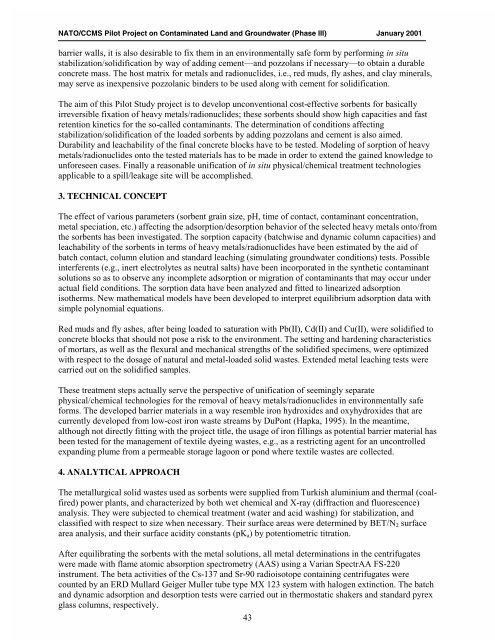NATO/CCMS Pilot Study Evaluation of Demonstrated and ... - CLU-IN
NATO/CCMS Pilot Study Evaluation of Demonstrated and ... - CLU-IN
NATO/CCMS Pilot Study Evaluation of Demonstrated and ... - CLU-IN
You also want an ePaper? Increase the reach of your titles
YUMPU automatically turns print PDFs into web optimized ePapers that Google loves.
<strong>NATO</strong>/<strong>CCMS</strong> <strong>Pilot</strong> Project on Contaminated L<strong>and</strong> <strong>and</strong> Groundwater (Phase III) January 2001<br />
barrier walls, it is also desirable to fix them in an environmentally safe form by performing in situ<br />
stabilization/solidification by way <strong>of</strong> adding cement—<strong>and</strong> pozzolans if necessary—to obtain a durable<br />
concrete mass. The host matrix for metals <strong>and</strong> radionuclides, i.e., red muds, fly ashes, <strong>and</strong> clay minerals,<br />
may serve as inexpensive pozzolanic binders to be used along with cement for solidification.<br />
The aim <strong>of</strong> this <strong>Pilot</strong> <strong>Study</strong> project is to develop unconventional cost-effective sorbents for basically<br />
irreversible fixation <strong>of</strong> heavy metals/radionuclides; these sorbents should show high capacities <strong>and</strong> fast<br />
retention kinetics for the so-called contaminants. The determination <strong>of</strong> conditions affecting<br />
stabilization/solidification <strong>of</strong> the loaded sorbents by adding pozzolans <strong>and</strong> cement is also aimed.<br />
Durability <strong>and</strong> leachability <strong>of</strong> the final concrete blocks have to be tested. Modeling <strong>of</strong> sorption <strong>of</strong> heavy<br />
metals/radionuclides onto the tested materials has to be made in order to extend the gained knowledge to<br />
unforeseen cases. Finally a reasonable unification <strong>of</strong> in situ physical/chemical treatment technologies<br />
applicable to a spill/leakage site will be accomplished.<br />
3. TECHNICAL CONCEPT<br />
The effect <strong>of</strong> various parameters (sorbent grain size, pH, time <strong>of</strong> contact, contaminant concentration,<br />
metal speciation, etc.) affecting the adsorption/desorption behavior <strong>of</strong> the selected heavy metals onto/from<br />
the sorbents has been investigated. The sorption capacity (batchwise <strong>and</strong> dynamic column capacities) <strong>and</strong><br />
leachability <strong>of</strong> the sorbents in terms <strong>of</strong> heavy metals/radionuclides have been estimated by the aid <strong>of</strong><br />
batch contact, column elution <strong>and</strong> st<strong>and</strong>ard leaching (simulating groundwater conditions) tests. Possible<br />
interferents (e.g., inert electrolytes as neutral salts) have been incorporated in the synthetic contaminant<br />
solutions so as to observe any incomplete adsorption or migration <strong>of</strong> contaminants that may occur under<br />
actual field conditions. The sorption data have been analyzed <strong>and</strong> fitted to linearized adsorption<br />
isotherms. New mathematical models have been developed to interpret equilibrium adsorption data with<br />
simple polynomial equations.<br />
Red muds <strong>and</strong> fly ashes, after being loaded to saturation with Pb(II), Cd(II) <strong>and</strong> Cu(II), were solidified to<br />
concrete blocks that should not pose a risk to the environment. The setting <strong>and</strong> hardening characteristics<br />
<strong>of</strong> mortars, as well as the flexural <strong>and</strong> mechanical strengths <strong>of</strong> the solidified specimens, were optimized<br />
with respect to the dosage <strong>of</strong> natural <strong>and</strong> metal-loaded solid wastes. Extended metal leaching tests were<br />
carried out on the solidified samples.<br />
These treatment steps actually serve the perspective <strong>of</strong> unification <strong>of</strong> seemingly separate<br />
physical/chemical technologies for the removal <strong>of</strong> heavy metals/radionuclides in environmentally safe<br />
forms. The developed barrier materials in a way resemble iron hydroxides <strong>and</strong> oxyhydroxides that are<br />
currently developed from low-cost iron waste streams by DuPont (Hapka, 1995). In the meantime,<br />
although not directly fitting with the project title, the usage <strong>of</strong> iron fillings as potential barrier material has<br />
been tested for the management <strong>of</strong> textile dyeing wastes, e.g., as a restricting agent for an uncontrolled<br />
exp<strong>and</strong>ing plume from a permeable storage lagoon or pond where textile wastes are collected.<br />
4. ANALYTICAL APPROACH<br />
The metallurgical solid wastes used as sorbents were supplied from Turkish aluminium <strong>and</strong> thermal (coalfired)<br />
power plants, <strong>and</strong> characterized by both wet chemical <strong>and</strong> X-ray (diffraction <strong>and</strong> fluorescence)<br />
analysis. They were subjected to chemical treatment (water <strong>and</strong> acid washing) for stabilization, <strong>and</strong><br />
classified with respect to size when necessary. Their surface areas were determined by BET/N2 surface<br />
area analysis, <strong>and</strong> their surface acidity constants (pKa) by potentiometric titration.<br />
After equilibrating the sorbents with the metal solutions, all metal determinations in the centrifugates<br />
were made with flame atomic absorption spectrometry (AAS) using a Varian SpectrAA FS-220<br />
instrument. The beta activities <strong>of</strong> the Cs-137 <strong>and</strong> Sr-90 radioisotope containing centrifugates were<br />
counted by an ERD Mullard Geiger Muller tube type MX 123 system with halogen extinction. The batch<br />
<strong>and</strong> dynamic adsorption <strong>and</strong> desorption tests were carried out in thermostatic shakers <strong>and</strong> st<strong>and</strong>ard pyrex<br />
glass columns, respectively.<br />
43
















